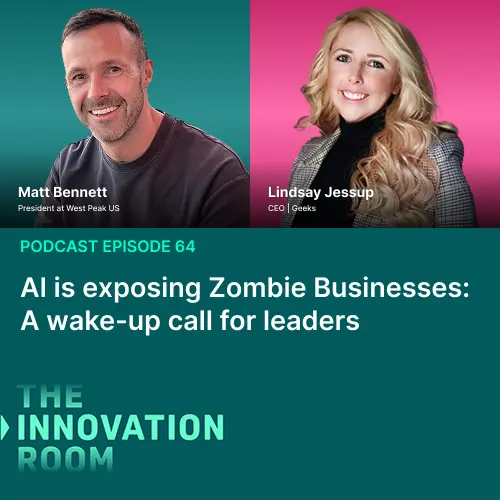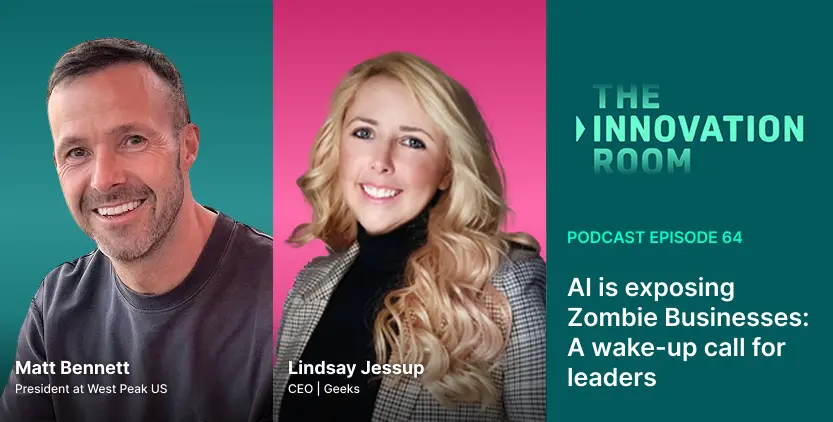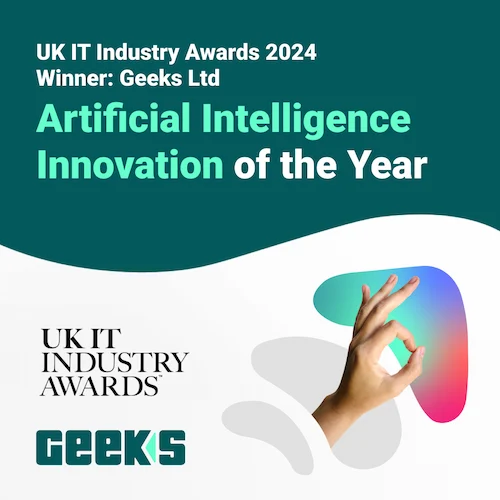
Why every business will have an AI agent layer within 3 years
The quiet shift you’ll hardly notice — until it’s everywhere
In the Conscious AI Agents webinar, Matt Mehrjardi, our CTO at Geeks, described this moment well:
"AI agents are not just smarter versions of chatbots. They observe, reason, and act in context. The power lies in how they quietly augment workflows, not replace them."
That’s exactly the shift we’re seeing, subtle but significant. Thin, intelligent layers are beginning to wrap around existing tools, not rip them out. You don’t notice the transformation all at once. It happens task by task: an invoice checked automatically here, a customer email triaged there. Then one day, your familiar dashboard feels slow because an agent showed what “instant” really means.
In a recent episode of The Innovation Room on augmenting teams, we explored how these layers aren't just changing tools, but reshaping team structures and delivery models.
At Geeks, we map this journey with our AI Adoption Framework:
Align → Experiment → Scale
Agents sit at the heart of the Scale phase, where organisations turn promising proof-of-concepts into everyday muscle memory.
This is not about AI as a standalone solution. It is about AI agents becoming part of the operational fabric, quietly streamlining decisions, reducing manual load, and changing how work gets done without disrupting what already works.
What we mean by an “AI Agent Layer”
An AI agent is a digital teammate that observes data, reasons against business rules, then acts through an API or escalates to a human. Crucially, the agent forms a layer on top of your ERP, CRM, or bespoke app, so you gain speed and coherence without ripping out core systems.
In the next three years, businesses will not need to ask whether they should adopt this model. They will need to decide how they are going to manage it because the teams that do it well will be operating faster, with fewer blockers, and more room for creative work.
Proof it is more than hype
The promise of automation is not new. What has changed is the maturity of AI agent tools and how easily they now integrate with existing systems. In the last year alone, we have seen a shift from experimental use cases to real operational deployment. These agents are no longer side projects. They are embedded into daily workflows, built quickly, scoped tightly, and deliver measurable results.
We have observed AI agents that:
-
Sort and tag incoming emails for triage
-
Guide customers through complex onboarding journeys
-
Monitor inventory, detect risks, and alert stakeholders
-
Support finance teams with reconciliation and reporting
-
Manage documentation for compliance and audit readiness
What sets these apart from legacy automation is their flexibility, contextual understanding, and ability to improve over time.
And this trend is only accelerating. Gartner forecasts that by 2028, 33% of enterprise software will include built-in AI agents, with 15% of daily business decisions handled autonomously. However, they also caution that more than 40% of early agent deployments may be abandoned by 2027 due to unclear business value or escalating costs.
Companies that move early and act deliberately secure an advantage, while those that 'play' with agents but skip governance risk expensive false starts.
Leading companies like Johnson & Johnson, Moody’s, eBay, and Deutsche Telekom are already showing what is possible. They are deploying agents for HR self-service, compliance automation, and analytics acceleration, not just to cut costs but to improve how work gets done across the organisation.
What this looks like in practice
Instead of 45 minutes spent manually reviewing supplier invoices, an AI agent reads the entries, flags anomalies, and drafts a summary.
Instead of toggling between six dashboards to prepare for a meeting, an agent pulls the latest metrics and packages a short brief.
Instead of junior staff answering the same onboarding questions every week, an agent walks new hires through the process, documents every interaction, and hands off to HR only when needed.
It is not magic. It is a good design, where the agent knows just enough to help and knows when to step aside.
Why will boards sign off on an agent layer
Not every business needs a fleet of autonomous AI agents. But most already rely on workflows where speed, accuracy, and visibility matter and where time is often lost chasing clarity.
Here’s why many companies will adopt this layer:
-
Time pressure – Let people focus on judgment, not admin.
-
Tool overload – An agent becomes the hub, reducing context switching.
-
Hiring limits – Drive growth without increasing headcount linearly.
-
Rising expectations – Customers and staff now expect instant, accurate answers.
-
Strategic flexibility – Pivot quickly when workflows aren’t stitched together manually.
The businesses that move first don’t just improve efficiency, they unlock strategic flexibility: the ability to pivot, scale, or experiment without waiting on new hires or complete platform rebuilds.
Common starting points we see at Geeks
|
Business Area |
Typical First Agent |
Quick Win |
|
Finance & Ops |
Invoice validation, reconciliation |
Shorter month-end close |
|
Customer Care |
Email and chat triage |
Faster first-response, higher CSAT |
|
Compliance |
Document tagging and audit trails |
Lower manual review hours |
|
Supply Chain |
Inventory alerts, ETA updates |
Fewer stock-outs and expediting fees |
How to begin without becoming a statistic
If this sounds right but still feels vague, the next step is not to start building. It is to get clarity on where AI agents can actually help.
-
AI Opportunity Discovery
A half-day workshop and data diagnostic to identify and rank 3–5 high-impact use cases. -
AI Agent Lab
A ten-day sprint to build a working agent on your live data, delivering code, metrics, and a clear scale-up roadmap. -
Momentum Sprint
Embed governance, success dashboards, and change management so your pilot survives budgeting cycles and turns into real value.
Final thoughts
Agent layers will seep into workflows, not crash in like a platform rollout. When they do, the organisations that aligned early, experimented quickly, and scaled steadily will already be reinvesting their freed-up hours into innovation.
Geeks, your total tech ally in the age of AI - is here to help you place that first agent exactly where it will matter most. Let’s talk about turning opportunity into operating reality.










